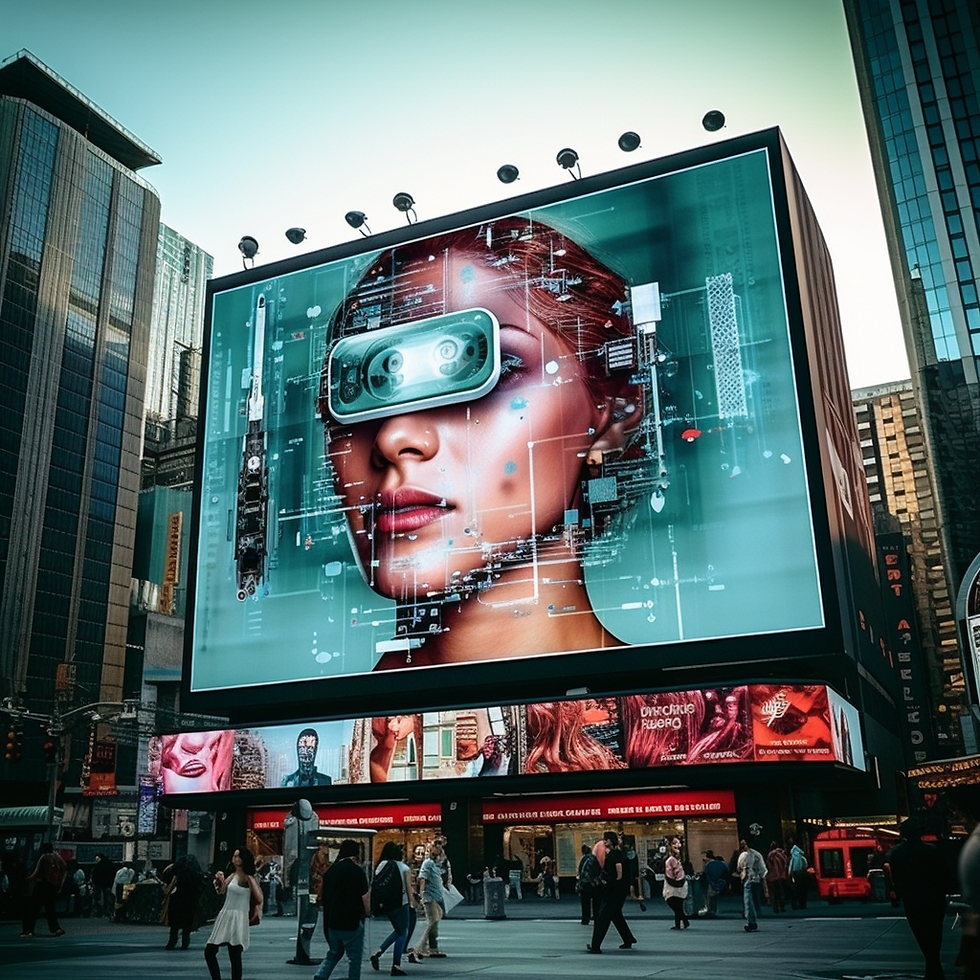🤖 Unmasking Deep Fakes: A.I.'s Mirage in the Digital Realm
- A.I. Ops Bot

- Feb 1, 2024
- 7 min read
Updated: Feb 9, 2024
1. A.I.'s Content Canvas: Crafting Realities Beyond Reality

In the vast tapestry of artificial intelligence (A.I.), a new and perplexing thread emerges – the world of "Deep Fakes." A.I. has evolved to a point where it can seamlessly create various types of content, from convincingly altered images and videos to eerily accurate audio simulations. As we unravel the layers of this technological marvel, it's crucial to understand the profound implications it carries. This article aims to dissect the types of content A.I. can craft today and explore the tantalizing marketing opportunities it presents for brands. Beyond the marketing realm, we'll delve into the societal impact of Deep Fakes, highlighting the dynamic shift they bring to cultural content and entertainment. Brace yourselves as we navigate the intricate landscape of A.I.-generated content, a realm where reality and illusion dance in a digital duet. As we venture into the realm of A.I.-generated content, the palette is vast and varied, offering a spectrum of possibilities that businesses can leverage for strategic purposes.
a. A.I.-Altered Images: Shaping Visual Narratives
Description:
A.I. can seamlessly alter images, morphing faces, backgrounds, and even entire scenes with astonishing accuracy. This extends beyond simple filters; A.I. can transform photographs, adjusting elements to create entirely new visual narratives.
Business Benefits:
For businesses, A.I.-altered images unlock a realm of creative possibilities. From crafting visually stunning advertisements to tailoring images for specific target demographics, brands can engage audiences with captivating visual content. Product placements, branding elements, and visual storytelling become dynamic tools, enabling businesses to curate an aesthetic that resonates with their audience.
b. Deep Fake Videos: A Cinematic Mirage
Description:
Deep Fake technology takes A.I.'s prowess to the next level, allowing it to manipulate video footage by superimposing faces, altering expressions, or even recreating entirely fabricated scenarios. The result is videos that appear authentic but are entirely synthetic.
Business Benefits:
For businesses, Deep Fake videos present an intriguing avenue for creative marketing. Imagine personalized video messages from virtual brand ambassadors, or the ability to seamlessly integrate products into narrative-driven content. This technology offers a fresh approach to video marketing, enabling brands to craft compelling and immersive storytelling experiences that resonate with their audience while reducing expensive production costs.
c. Synthetic Audio: The Power of Virtual Voices
Description:
A.I. can mimic human voices with remarkable accuracy, creating synthetic audio content that ranges from voiceovers to entire podcasts. The technology captures the nuances of intonation, pacing, and emotion, making it challenging to discern from genuine recordings.
Business Benefits:
In the realm of audio marketing, businesses can harness synthetic voices for a myriad of applications. From creating on-brand voiceovers for advertisements to developing virtual assistants with distinct personalities, the possibilities are vast. This technology enables businesses to maintain brand consistency across various audio channels, enhancing the auditory identity they present to the world.
d. A.I.'s Content Symphony for Business Innovation
As we unravel the diverse content types A.I. can produce, businesses find themselves at the intersection of innovation and imagination. A.I.-altered images, Deep Fake videos, and synthetic audio unlock new avenues for creative expression and strategic brand communication. The business benefits extend beyond mere novelty, offering practical applications in marketing, branding, and customer engagement. In the ever-evolving landscape of A.I.-generated content, brands that embrace these tools stand poised to redefine how they connect with their audience, crafting narratives that resonate in the hearts and minds of consumers. Stay tuned as we delve deeper into the implications and considerations surrounding the integration of A.I. in content creation for businesses.
2. Deep Fakes as Cultural Resonance: The Ghosts of Creativity Past

In the ever-expanding digital frontier, Deep Fakes transcend the realm of mere technological novelty, unlocking a potential boon for cultural preservation and innovation. Imagine a scenario where the unique comedic stylings of a legendary figure like George Carlin, now departed from the mortal stage, can be resurrected through the artistry of A.I.
a. Reviving the Voices of Comedy Legends
Scenario:
Picture an A.I. model meticulously trained on the extensive body of work left behind by George Carlin – his iconic routines, distinctive comedic timing, and unparalleled linguistic flair. With this wealth of data, A.I. has the potential not only to mimic Carlin's style but to create entirely new comedic content that feels authentic to his inimitable voice.
Cultural Impact:
This application of Deep Fakes could breathe new life into the comedic legacy of George Carlin, allowing audiences to experience fresh material that captures the essence of his humor. This not only pays homage to the late comedian but introduces his unique perspective to a new generation, fostering cultural continuity and preserving the spirit of comedic brilliance.
start.
b. The Business Model of Cultural Continuity
Potential Business Model:
The business implications of leveraging Deep Fakes for cultural preservation are profound. Imagine a platform or service offering subscriptions to access new content created in the style of beloved artists, comedians, or musicians who have left an indelible mark on culture. This model could generate revenue through subscriptions, licensing agreements, and partnerships, creating a sustainable ecosystem that benefits both content creator estates and audiences.
Comparison to Immortality:
While not a literal path to immortality, this business model echoes the timeless human quest for a form of digital transcendence. By perpetuating the artistic legacies of cultural icons, it offers a glimpse into a future where the essence of creativity endures beyond physical lifetimes. It also opens up new avenues for artists to continue contributing to cultural conversations long after their earthly presence has ceased.
c. Deep Fakes as Cultural Custodians
In exploring the potential for Deep Fakes to channel the artistic spirit of departed legends like George Carlin, we unearth a fascinating intersection of technology and cultural continuity. The business model that emerges from this synthesis not only offers entertainment value but becomes a custodian of cultural heritage, fostering a connection between past, present, and future. As we navigate the ethical considerations and societal impacts of this technological marvel, the prospect of Deep Fakes as cultural custodians challenges our perceptions of creativity, legacy, and the enduring resonance of human expression. Join us on this thought-provoking journey as we unravel more layers of the Deep Fake phenomenon and its impact on the cultural tapestry of tomorrow.
3. Deep Fakes in the Ethical Abyss: Navigating Risks and Brand Integrity

While the prospect of resurrecting cultural icons through Deep Fakes presents an intriguing narrative, it also plunges us into an ethical abyss fraught with risks. In a world where the original content creator is no longer present to provide consent or disapproval, the challenges and potential pitfalls for brands navigating this uncharted territory become abundantly clear.
a. Ethical Dilemmas: The Void of Consent
Challenges:
The absence of explicit consent from the original content creator introduces ethical uncertainties. How can we ensure that A.I.-generated content aligns with the creator's values, preferences, and intended messaging when they are no longer able to voice their approval or objection?
Risks to Brands:
For brands utilizing Deep Fakes, the risks are multifaceted. A misalignment of values, messaging, or ethical considerations in A.I.-generated content could lead to reputational damage. Brands may inadvertently associate themselves with content that contradicts their established ethos, causing confusion and potential backlash from audiences.
b. The Challenge of Brand Alignment
Ensuring Alignment:
Brands must grapple with the challenge of aligning A.I.-generated content with their messaging, morals, and ethics. The risk of inadvertently endorsing content that contradicts brand values becomes a significant concern, particularly when dealing with sensitive topics or controversial figures.
Adding Layers of Security:
To mitigate these risks, brands can implement robust authentication processes. This may involve leveraging blockchain technology to verify the authenticity of A.I.-generated content, ensuring that it adheres to predetermined brand guidelines. Establishing a clear framework for ethical considerations and regularly auditing A.I.-generated material can add layers of security to the content creation process.
c. Audience Relevance and Sensitivity
Navigating Audience Expectations:
Brands walk a tightrope between creating engaging content and respecting the sensitivities of their audience. A.I.-generated material may inadvertently strike the wrong chord, alienating or even offending the target demographic.
Authenticity Measures:
Brands can safeguard audience relations by integrating authenticity measures into their A.I. content strategy. This includes transparently communicating the nature of A.I.'s involvement, ensuring that audiences are aware of the technology's role in content creation. Establishing a feedback loop with consumers can also provide valuable insights into the reception of A.I.-generated content.
d. Safeguarding Brand Identity in the A.I. Era
As we navigate the uncharted waters of Deep Fakes and their potential implications for brands, the imperative to safeguard brand identity, ethics, and audience relations becomes paramount. The ethical dilemmas surrounding consent, the challenge of brand alignment, and the delicate dance of audience relevance demand proactive measures. Brands can fortify themselves against potential risks by implementing authentication processes, transparently communicating A.I.'s role in content creation, and establishing an ongoing dialogue with their audience.
4. Assimilating A.I. into Marketing Frontiers

As we stand at the crossroads of A.I.-propelled content creation and marketing innovation, the journey ahead promises both challenges and unprecedented opportunities. To seamlessly assimilate A.I. into the corporate structure, particularly in the realm of marketing, brands must consider forward-thinking strategies that not only protect their image and reputation but also unlock new avenues for monetization.
a. Licensing Rights: The Shield and the Sword
Protecting Image and Reputation:
Licensing rights emerge as a powerful tool for brands to safeguard their image, likeness, and overall reputation. By establishing clear licensing agreements, brands can dictate the parameters of A.I.-generated content, ensuring alignment with their values, messaging, and ethical standards. This not only protects brand integrity but also serves as a shield against inadvertent misrepresentations.
Monetizing Opportunities:
Simultaneously, licensing rights open doors to monetization opportunities. Brands can explore avenues for licensing A.I.-generated content to other entities or even licensing the technology itself. This dual function transforms licensing from a defensive strategy into a proactive means of leveraging A.I. for both brand protection and financial gain.
b. Responsibility and Guardrails
Questioning Responsibility:
As A.I. content creation proliferates, a crucial question arises: Who bears responsibility for the content A.I. generates? Is it the end user who commands the technology, or is it the responsibility of the open-sourced platforms to erect the necessary guardrails that protect image and likeness rights?
Call to Reflection:
The user must ponder this question, for it delves into the heart of ethical considerations and the evolving landscape of technological accountability. In an era where A.I. weaves itself into the fabric of content creation, the call to reflection prompts us to contemplate the responsibilities inherent in shaping the narratives that define brands, individuals, and cultural conversations.
As we navigate the landscape of A.I. in marketing, the amalgamation of protective measures such as licensing rights and a thoughtful reflection on responsibilities becomes paramount. Brands poised on the frontier of this technological evolution stand to not only shield themselves from potential pitfalls but also to wield A.I. as a transformative force in crafting narratives that resonate with authenticity and purpose. Stay tuned as we continue to peel back the integration of A.I. into our marketing endeavors, where innovation and ethical considerations coalesce to shape the future of brand storytelling.

















